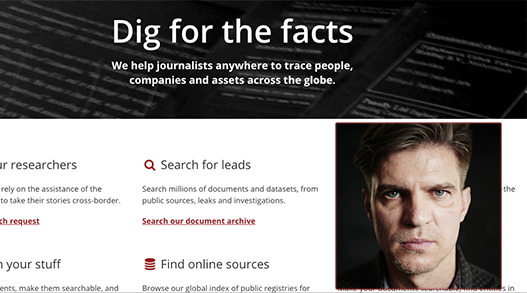SECRETS OF THE MASTERS
Advice to Reporters: ‘Be Inventive and Patient’
Bulgarian investigative journalist Alexenia Dimitrova reveals how she uses Freedom of Information laws in several countries to uncover secrets.
Bulgarian investigative journalist and author Alexenia Dimitrova reveals how she uses Freedom of Information laws in several countries to uncover hidden secrets of the Cold War, how the imprisonment of her father spurred her on, and the rewards of patience.
Share with us a story or investigation that you pursued and the impact it had.
I am keen on investigations that find irrefutable evidence about things that people have, up to then, only ever rumored or doubted.

I turned one such investigation into my fourth book “Murder Bureau”, which proved the past existence of a secret government-run killing unit.
Another investigation proved the existence of an overdose of mercury in the brain of the former Bulgarian Communist leader George Dimitrov. I substantiated rumors that Dimitrov had probably been poisoned during the regime of Stalin.
“Murder Bureau” was based on nearly 5,000 pages of previously unknown documents from the Bulgarian archives. The documents were declassified at my request under a law passed in December 2006.
I had pursued this story since 1993, when I first read allegations about a secret unit that was said to be responsible for the poisoning, kidnapping, eradication, discrediting, or demoralization of Bulgarian emigrants abroad.
According to the rumors, the unit existed long before the notorious assassination of the Bulgarian writer Georgi Markov in London in 1978.
Markov, an exiled broadcaster and journalist, famously died after a micro-engineered pellet containing the highly toxic poison, ricin, was fired into his leg, via an umbrella wielded by someone associated with the Bulgarian secret police.
My initial efforts to obtain documentary proof of the existence of the unit from the Bulgarian Ministry of the Interior and the National Intelligence Service failed. I was refused access to the material I needed.
But then in 2006 a new law was enacted that gave researchers access to previously secret archives. That’s when I struck gold – 40 previously unseen files, containing more than 5,000 pages of the activities of the unit.
The documents contained people’s names. I was then able to track some of the people down to flesh out my research. I reproduced about 100 of the original documents in my book.
As for the case of George Dimitrov (not my relative – it is a very common Bulgarian family name), I was able to substantiate the rumors that Dimitrov had probably been poisoned.
I did this by commissioning tests on DNA obtained from Dimitrov’ hair and brain – his mummified body had only recently been buried – using three different testing laboratories.
The tests showed that Dimitrov had high levels of mercury in his hair and brain at the time of his death – high enough to kill him.
What is the path that led you to investigative journalism in the first place?
My interest in investigative journalism began in 1989, immediately after the fall of Communism in Eastern Europe.
The long kept secrets by the previous totalitarian regime were finally about to be exposed and I was lucky to be at the right place at the right time. I was young enough not to be burdened with the fear of authority that blighted the previous generation.
The first topic that attracted my attention was the flow of Communist money out of Bulgaria and the later return of this same money during the process of privatization.
I researched and exposed the ways in which people in high-level political positions acquired their luxury homes and cars.
I also reported on wrongs that were carried out by those in positions of power, which until then had been hidden thanks to political influence.
What methods, techniques and tools have served you best as an investigative journalist?
As I already mentioned, I have always been keen on finding documents that back up the stories that I am researching. I then try to enrich the documents by tracking down the people involved.
I make extensive use of Freedom of Information laws both in Bulgaria and in the U.S.
Before the collapse of Communism in 1989, no one even dared to think of writing requests to the Ministry of Internal Affairs.
When I studied in the USA in 1996, 1998 and 2006 I discovered the strength of the American Freedom of Information laws. I started requesting documents related to Bulgaria from the U.S. institutions. Since 1998, I have sent almost 700 FOIA requests to about 10 U.S. institutions.
My interest in the history of Communist times originates from a personal story. My father spent almost two years in two of the most severe labor camps in Communist Bulgaria because of his disagreements with the then-regime.
How has the increasing importance of digital and online media (especially the immediacy factor they emphasize) impacted the quality and practice of investigative journalism?
Of course, it has a great influence on my job but I still envy my colleagues worldwide who can enjoy the full range of tools offered by the digital and online media. Some of these tools are not yet widespread in my country.
Have you employed a lot of data-based methods in your investigative reporting? If yes, what kinds of data do you use and how?
Unfortunately, no.
Talk about your approach to stories. Is there anything unusual about the way you conduct your research or choose your themes?
When it comes to pursuing stories, I tend to be more patient than other reporters. I often find myself pursuing a topic or an issue for years and I spend long hours exploring individual facts and documents.
I also seem to have the ability to feel and see things far beyond what first appears on the surface of a story or issue.
What do you consider some of the most important lessons you have learned over the years?
When I teach journalism to others, one of the most important lessons I try to instill in my students is to be unbiased. I ask them not to pre-judge a story and not to assume the outcome when doing initial research. I teach them to stick only to the facts and that they need to verify those facts using as many sources as possible.
Another important lesson is not to give up easily – that there are often many obstacles to overcome. I also try to teach my students to be inventive and patient when they look for information.
What are the key elements that make an investigative story truly “click”? What do they have to have and what should they not be missing?
- Pick a good title that illustrates an attractive and unique topic.
- Illustrate your story with as many documents as possible to give the readers a sense of credibility and truth.
What is the biggest single threat to investigative reporting and what advice can you give to others?
The biggest threat today is the lack of time given to reporters. Years ago, when the editorial offices were larger, more reporters were involved in making good in-depth investigative journalism. Now it seems the main game is to chase clicks on web pages and to constantly update stories. Investigative stories are less esteemed, pursued and appreciated.
What other tips would you give young, emerging, investigative reporters?
I would advise them not to spare any efforts to find as many different sources as possible, even if they are unable to be used in the final product.



